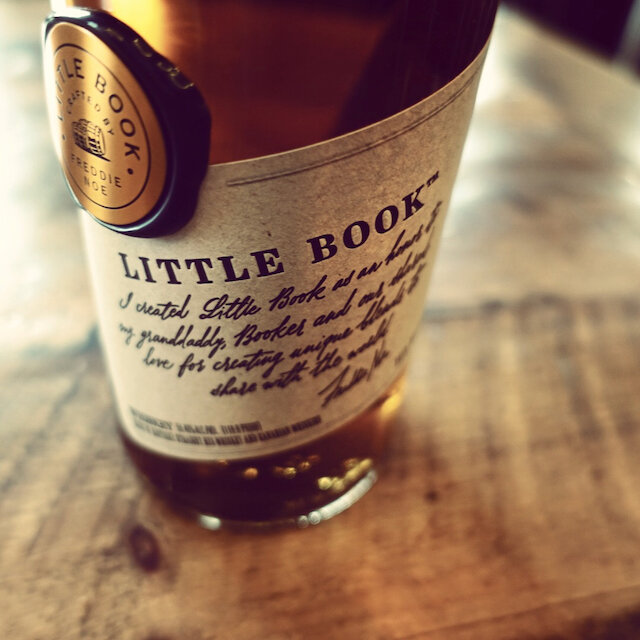The First Three Chapters of Little Book - A Review of American Whisky!
/Little Book is the brainchild of Freddie Noe, the son of Fred Noe of the Jim Bean distilling legacy. Thus far we’ve had three chapters, and all of them had a different view of what’s considered “American whisky.” None of them are bourbons or ryes. One of them isn’t even an American whisky!
I’ve been really impressed with the series. While Chapter 1 was a play of possibilities, Chapter 2 brought a blend of Canadian and American whisky, and Chapter 3 brought it back to basics and is the most bourbon-like of them all. While it’s hard to pick a favourite (I enjoyed them all), Chapter 3 is undoubtably going to be the biggest hit of the already popular series.
Before we begin, let’s get a few whisky 101 definitions out-of-the-way. The Straight Bourbon and Straight Rye category in the US is the strictest whisky category in the world—everything is controlled from the mash bill recipe used (51% corn for bourbon, 51% rye for rye), the proof point it’s distilled to, the barrel proof entry, and the time aged in the barrel. The challenge is, how do you make new flavours when everyone is using the same essential recipe? That’s not really been an issue before bourbons and ryes became very popular, but people want new products, and Freddie Noe stepped up to the plate to hit a few home runs.
The name, Little Book, has a fun reference. It’s the nickname that Booker Noe (grand-father) gave to Freddie Noe because of how much Freddie reminded Booker of himself. Booker Noe was the Jim Beam Master Distiller behind the previously labelled small batch selections, which includes Booker’s Bourbon, Knob Creek, Baker’s, and Basil Hayden. All those elements are brought back together in Chapter 3.
Chapter 1: “The Easy.”
Possibly the most ambitious of the three, the first chapter is a blend of many different whiskies that Jim Beam Distillery makes. It’s ambitious because “The Easy” didn’t depend on big name blends, and rather was a blend of uses popular whiskies.
Proportions went unmentioned, but it’s a blend of a four-year-old bourbon, a 13-year-old corn whiskey, an approximately six-year-old straight rye whiskey, and an approximately six-year-old straight malt whiskey. Jim Beam doesn’t make a lot of straight single malts, so one can assume some of these blends came out of the experimental series Freddie Noe has been working on.
It’s the least “bourbon” of the bunch. I found it a little too soft, but there’s an interesting uniqueness to the flavour profile. I just didn’t know how to categorize it. In reading other reviews, I think Breaking Bourbon puts it best:
With Little Book, it’s interesting because the bottle isn’t from a craft whiskey distillery experimenting with something new. It comes from one of Kentucky’s major distilleries and serves to introduce the world to the company’s next generation master distiller. It challenges the drinker, presenting a flavor profile that pushes the envelope of a traditional flavor profile. But not so far that it breaks any established barriers. While some will go so far as to find the flavor profile a bit odd, I do think there will be some who downright dislike it. With multi-whiskey-type blends, the various whiskeys can sometimes come together in a much more subdued nature than might be expected, each kind of mellowing the unique characteristics of the others. Alternatively, they can bring out the worst in one another. Fortunately, in this case the end result doesn’t taste like a Frankenstein whiskey, or one that has been overly subdued. The whiskeys marry together nicely but don’t overpower one another, delivering an end result that’s uniquely different in an elegant and well-balanced way.
That nails it for me. I couldn’t say it better myself.
My tasting notes:
Little Book Chapter 1: “The Easy”
Distillery: Jim Beam
Category: New Oak, NAS, 64.1% ABV
Blend: 4 year Bourbon, 13 year corn whiskey, 6 year 100% malt whiskey, 6 year high rye bourbon
Score: Become a Patron
Nose: Caramel, very present new oak char, a dusty barnyard note, touches of anise. It nosed a little young, but with a swirl of some older barrels.
Palate: That nutty Jim Beam note with light oak tannins and spice. Herbal like vermouth, but so very light, like anise. Lots of oak notes come through toward the finish.
Conclusion: A little too fancy in complexity is my only complaint, and so I found that distracting. The different flavour components come through in the end, though. It’s a terrific sipping whisky at this proof point, it’s not something that makes you “feel the pain” of 64.1% ABV. .
Chapter 2: Noe Simple Task Review
“Noe Simple Task” blends 8 year old cask strength Jim Beam Rye with 13 Year Old Alberta Distillers Rye, and 40 Year Old Canadian whisky (similar to Canadian Club 40 Year Old). It’s an insane blend, and it comes with some terrific flavour possibilities. All this is made possible because Beam Suntory owns Alberta Distillers and has a share of Hiram-Walker Distillery production.
While this hasn’t been confirmed, my guess is that the 40 year old Canadian Whisky came from the same stock that Canadian Club 40, 41, and 42 are using. It’s really old stuff. The casks are mostly saturated, light, and bring out a nice candied note in the drink. They’re a great layer for flavour, and even in the Canadian Club series, they get blended in with young ryes and fortified wines.
While Alberta Distillers isn’t confirmed as the 13 year old Canadian rye (it could be Hiram-Walker’s rye, for example), the flavour components of Chapter Two have such high influences of what I’d associate with Alberta Distiller’s flavours that I find it hard to believe it’s anything but. In fact, that rye note comes through so wonderfully, that it really makes the whisky for me.
Little Book Chapter 2: “Noe Simple Task” Review 59.4% ABV
Distillery: Jim Beam Distillery, Hiram-Walker Distillery (unconfirmed), and Alberta Distillers (unconfirmed)
Blend: 8-Year-Old Rye, 13-Year-Old Canadian Rye, 40-Year-Old Blended Canadian
Category: American Whisky, Canadian and American Blend
Score: Become a Patron
Nose: Terrific yeasty grainy turning fruit notes, boozy cherries, some barnyard notes, butterscotch sweetness. The hard lemon peel note is all from that Canadian Club 40, and it’s buttery and lemony and wonderful.
Palate: Lots of tannins, crushed blood orange early on. Dusty. Brash. Surprisingly dry. Butterscotch note is present, as well as some vanilla sweetness. Its spicy and dark fruit finish is dry.
Conclusion: I’m admittedly a sucker for the Alberta Distiller’s rye. It’s a unique flavour note that I generally don’t find anywhere else. Combine that with the Canadian Club 40 year old whisky lemon candy note, this is a terrific pour of complex whisky. The Jim Beam rye adds a ton of pizzaz to the drink. It’s a whisky that’s easily deconstructed into its core elements, and beautifully blended.
For another perspective, check out In Search of Elegance and Toronto Whisky Society.
Chapter 3: The Road Home
The Road Home is all about Straight Bourbon, and even though this isn’t a straight bourbon (it’s a blend of two different mash bills), it’s flavour is all bourbon. Some might call this a Frankenstein blend of Jim Beam whisky, because it brings together the Knob Creek mash bill together with the Basil Hayden mash bill at cask strength levels.
I really enjoyed this one. It’s my favourite of the bunch. It’s also the most typical of the bunch. The ideas behind this whisky aren’t as crafty, but I have a feeling Freddie Noe had his pick of the litter of barrels after the success of the first two chapters.
It’s unknown how many chapters we’re going to have, but the first three chapters complete the American whisky story with the last one being the most bourbon-y of the bunch where as the other two brought out the best of the general American whisky category.
Little Book Chapter 3: “The Road Home” 61.3% ABV
Category: American whisky blend
Blend: Knob Creek/Baker’s/Booker’s mash bill (77% Corn, 13% Rye, and 10% Malted Barley) blended with the Basil Hayden mash bill (63% Corn, 27% Rye, and 10% Malted Barley).
Score: Become a Patron
Nose: Nice oaky boozy cherry nose. A little dusty. Lots of dark fruits drenched in alcohol. It’s sweet, cinnamon spicy, and so damn inviting. Quiet, in the way high-proof bourbons, are quiet on the nose.
Palate: Boozy cherry, cinnamon spice, tart sweetness, plenty of vanilla, and whipped-cream creamy. The rye notes are prominent, but so is the oak spice. It has that sweet buttery tangy note that sticks to the palate through the finish like many of the bourbons in this high-proof category.
Conclusion: Fans of high-proof bourbons will sink right into this. It’s gentler than a Stagg, less herbal than a Handy Rye, more put together than the Barrell Bourbon I enjoyed earlier in the year. At this price-point you want to feel like you’re drinking something special, and that you are. I almost prefer this over a Stagg, because this is slightly more ‘everyday sipper’ than your average Stagg release. It’s more similar to some of the Four Roses annual releases. Basically, given a bottle, I’d drink it. Thanks for the sample Ray!
Final note: At the time of this posting, you can still get Little Book Chapter 3! It’s costly ($130sh US), but if you enjoy high-proof bourbon and ryes this will hit the mark perfectly. It’s closer to the Four Roses special release than it is to Buffalo Trace Antique Releases, but it’s in that same genre of flavour profiles.




